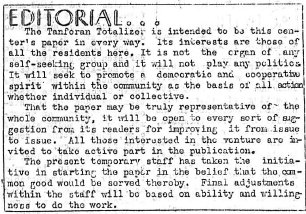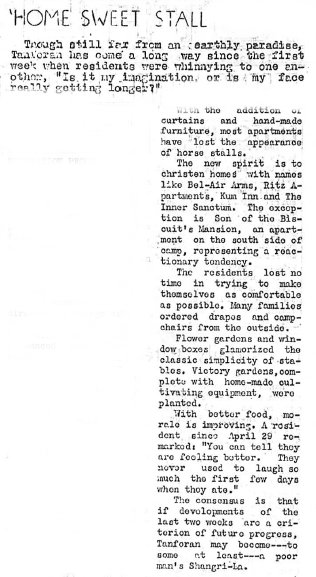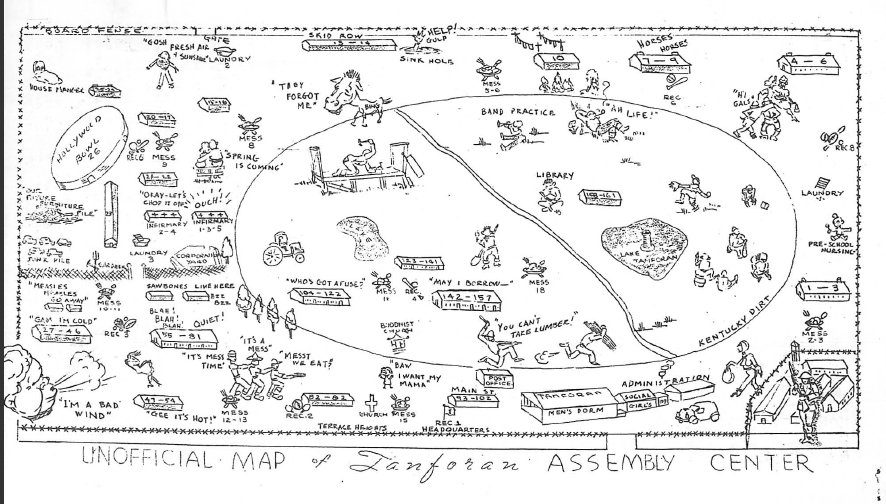
Tanforan Totalizer, Issues 1 through 5
Vol.1 #1: May 15, 1942

The masthead for the paper. Basically apolitical, noting the location of camp and the concept of “totalizer” probably used for meaning “all the news.”

The opening editorial. The paper is going to try to avoid getting into any national political arguments, or involved in any in-camp politics.

The head of the assembly center greets the internees. He stresses that the success of the camp depends on everyone trying to get along and adhere to the rules, which will be kept basically minimal and simple. Violation of any of the rules, though, will be dealt with strictly. Overall it's a pretty normal type of introduction, impressing on the residents who is ultimately in charge, but that they will have as much control of their own lives as possible.
The first page also talks about the camp handling some 6000 pieces of day, the need for people to get their typhoid shots and smallpox vaccinations, and the fact that one female baby was born.

The second page gives advice to people who are putting together their own furniture. It also talks about the recreation centers and art classes, and then has an interesting article entitled “Living in Stalls,” which, in fact, is what the residents were living in - former horse stalls.
The third page talks about the kitchen, and how there's a special place for babies and invalids. Weekend church services are held for Protestant, Catholic, Buddhist and Seventh Day Adventist groups. There's also a small ad for buying war bonds and stamps.

A very interesting map of Tanforan.
Vol.1 #2: May 23, 1942
The first page notes that the population of Tanforan was 7796 as of that day. There had also been two more births at the camp. There is also an article noting that applying for camp jobs would not be necessary, since all the internees had already been classified from their documents and someone would contact them with a job offer that fitted their qualifications.
The second page lists the job classifications, and it's a long list. The third page has an article on items turned in to the lost and found, editorials, an article requesting anyone who has a Chinese rice kettle to turn it in to the mess hall, and an article on one particular internee.
The last page has an article on recreation, one on softball, one on church services, one on Protestant plans in particular, one on the first town hall meeting, one on the medical center, and a note that people need to put complete names on their letters.
Vol. 1 #3: May 30, 1942
Page 1: This is their Memorial Day issue. There has been over 1000 visitors to the camp in the previous ten days. Also, a Personal Aid Bureau has begun operations.
Page 2: There's an article about the camp's library. An art program has started, and young men are reminded to inform the draft board of their current address.
Page 3: Classes in music have gotten underway, and school for young children has opened. At the moment it will be for the first three grades, have four teachers, and up to 300 children. Students 8 and up will have classes starting in around ten days, and there will also be classes for adults. Those would include classes in English, Civics and History.
Figuring the number of students per class is somewhat difficult. There are three grades, so we can assume 100 students to a grade. There are four teachers, though, and there's nothing said about how the students would be divided among the teachers. The odds favor rather large classes, though, maybe up to 75 students in a class. That would make teaching very difficult, not counting the rather primitive conditions, lack of books, etc.
Page 4: There's an article on the kitchen, one on the medical center, with two babies born. There's an article on House Managers, and a note that the paper needs an art editor.
Page 5: This is a “women's page.” There's tips on keeping the place looking nice and sending out laundry, along with an article on a nursery school at the camp. There's also an article on clothing for girls.
Page 6: Part of this page deals with sports. Softball is discussed. There are also going to be first-aid classes. Center Buddhists are organizing, and a list of Christian services is given, along with a rather strange little article on 1,400 milk bottles that have somehow gone missing.
Vol. 1 #4: June 6, 1942
Page 1: Residents are going to elect five councilmen. There was a discussion on what the Nisei attitude should be toward the evacuation, and all the noted speakers said they should go along with things. A WRA place for getting workers for sugar beet fields in Oregon, Idaho and Montana was discussed. Finally, a short article on some movies would be shown some time in the future.
Page 2: There's an article noting that no more visitors would be allowed on Mondays, but no reason for that decision is given. The page also talks about the post office, a new police chief, and someone new added to the Personal Aid Bureau.

An example of various activities at the center.
Page 3: Editorial comments, an article about one of the internees, and a note that school is starting for 4th and 5th graders. They will be around 350 students and 8 instructors. That works out to a little over thirty students per class.

There's an article on what we would now call recycling.
Page 4: An article on the kitchen, one on the music studio, an article about a Christian seminar series starting, a note about 6 births, and an ordination.
Page 5: The women's page. One interesting thing is the rumor that some 700 of the women were pregnant. The camp doctor notes that only around 30 are. There's a short article about an 83-year-old woman, and an article about some newlyweds. Girl's recreation has a short article, and there's an article on fashion and household tips.
Page 6: Almost the entire page is taken up with articles about softball in the camp.
Vol. 1 #5: June 13, 1942
Page 1: The entire page is taken up with articles on people running for council in the camp.
Page 2: There's an article on the lost and found, and one on procedures in cashing money orders. One article talks about the fact that around 20% of the internees at the camp are working at various camp-related jobs. All profits from the camp store are sent to the U.S. Treasury.
There's an interesting article on fire fighting. The article says that the camp has had five small fires in the last month while other camps run around two small fires a day. There's also an article about draft forms that are filled out and the person doing it has to take an oath that will be given by the postmaster of the camp.
Page 3: More material on the various candidates for camp council. More sugar beet workers are needed. Town Hall heard a WRA talked about relocation areas. An occupation survey is going to be taken to help place people in industrial relocation projects.

I also found this interesting. Another resemblance of camp and prison life.
Page 4: An editorial on the upcoming camp election. Various concerts, talent shows, and other musical-related things at the camp is discussed. There's a letter to the editors, and a small article on 600 attending a flag ceremony.

This is very interesting. I've read elsewhere of projects like these, where internees were making things that would help people identify planes. Such a thing would be given to spotters, and could prove very useful for the war effort.
Think about this for a minute. These people were required to leave their homes and businesses. They lost much of their personal property. Their assets were frozen. They were put into internment camps even though they were not arrested or charged with anything, or given any sort of trial or hearing, or allowed any sort of appeal. Yet they are willing to do something which will help the very people that put them behind the barbed wire.
I think that says a lot of positive things about the character of the internees.
Page 5: Short editorial bits, and an article asking people's opinions about something, this time whether women should marry younger men. There's also an article noting that books from the California state library could be borrowed through the camp's library.
Page 6: There's an article on the kitchen, one noting that there have been three births and one death (no cause given), new art classes, and a reward for a lost money belt. High school classes are due to start the following Monday. There will be three classes each afternoon, five days a week.
Page 7: An article on whether there are problems raising children in the camp; tips of the week; an article on knitting, an article on one resident, and an article on the general things a girl does who works as a waitress in the camp.
Page 8: Sports, with articles on softball in the camp, current team standings, an article about sumo classes that will be offered, new athletic equipment has arrived, and new first aid classes will be held.
Main Index Page
Main Photo Page
|